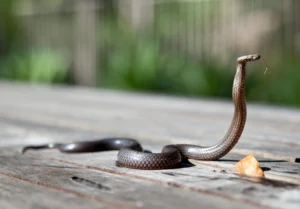The 10 most dangerous snakes in the world

Millions of people face snake bites every year all around the world, but what are the most dangerous snakes that could cost humans their lives?
Snakes bite about 5.4 million people each year, resulting in approximately 81,000 to 138,000 deaths, according to the World Health Organization. Venomous snakes kill their prey with toxic substances produced in modified salivary glands, and then the snake injects them into the victim using its fangs.
These toxins have evolved over millions of years to cause severe reactions in the victim, ranging from paralysis and bleeding to tissue death and inflammation. Here are 10 snakes whose venom can be lethal enough to kill a human.
- The black mamba.
The black mamba (the most dangerous snake in Africa) can kill a person with just two drops of venom. Although the brown mamba is brown in color, it is called black due to the dark color of its mouth. Its average length is about two and a half meters, and it can move at a speed of 19 km/h. Baby mambas are born with two to three drops of venom in each fang, making them deadly from the start.
By the time she reaches puberty, she is capable of storing up to 20 drops of venom in her fangs. According to Kruger National Park, a mamba bite without treatment can be fatal.
Once the venom is injected into the victim’s body, they suffer from paralysis or cardiac arrest. Although scientists are not certain about the number of people killed by mambas each year, they confirm that it is responsible for the highest number of snake-related deaths in South Africa.
- The tip of the spear.
This type of snake lives in Central and South America, and its length ranges from 1.2 to 2.5 meters. It weighs about 6 kilograms. A female can give birth to 90 fierce offspring. The fer-de-lance snake is responsible for half of all snakebite envenomation cases in Central America. Since its venom contains an anticoagulant substance, its sting can cause bleeding in a person.
- The green tree
The green tree snake lives throughout Africa, primarily in Eswatini, Botswana, Namibia, Mozambique, and Zimbabwe. It is considered one of the most venomous snakes known as rear-fanged snakes, according to the Museum of Zoology at the University of Michigan. Such snakes can retract their fangs back into their mouths when they do not need to use them.
Like other venomous snakes, this one contains a blood toxin that causes its victims to bleed internally and externally.
- The Eastern Tiger
The eastern tiger snake originates from the mountains and pastures of southeastern Australia, and its bite can cause poisoning in humans within 15 minutes after the bite. It is responsible for at least one death per year on average.
- Russell’s viper

Around 58,000 deaths in India are attributed to snake bites each year, with the Russell’s viper responsible for the majority of these fatalities. In Sri Lanka, where this nocturnal snake likes to rest in rice fields, it causes a high mortality rate among rice farmers during harvest time. Researchers reported in the Clinical Neuroscience Guide in 2014 that snake venom can lead to a range of symptoms, such as acute kidney failure and severe bleeding.
In rare cases, symptoms similar to Sheehan’s syndrome appear, where the pituitary gland stops secreting certain hormones.
- A saw-scaled viper.
The saw-scaled viper (Echis carinatus) is the smallest member of the “big four” in India—alongside the Russell’s viper, the common krait (Bungarus caeruleus), and the Indian cobra (Naja naja)—and is believed to be responsible for most of the bites and related fatalities in the country.
Once this snake bites, the person will experience swelling and localized pain in the area, followed by potential bleeding. Since the poison disrupts the victim’s ability to clot blood, leading to internal bleeding and ultimately acute kidney failure, an antidote must be administered to the victim within hours of the sting in order for the person to survive.
- Krit with stripes
This snake moves slowly during the day and becomes active at night. Its sting can paralyze the muscles and prevent the diaphragm from moving, which stops air from entering the lungs, causing the victim to suffocate.
- The king cobra
It is considered the longest venomous snake in the world, reaching a length of 5.4 meters, according to the Natural History Museum in London.
The eyesight of this snake allows it to detect a moving person from about 100 meters away. When threatened, a cobra can raise its head off the ground by about a third of its body length, according to the San Diego Zoo.
The fame of the king cobra is not due to the potency of its venom, but rather to the amount of venom it injects into its victims. Since each bite provides about 7 milliliters (0.24 fluid ounces) of venom, the snake tends to strike with three or four quick bites. This sting can kill an adult in just 15 minutes and an elephant in a few hours.
- Coastal Tyban

An incredibly fast snake that can jump at tremendous speeds, according to the Australian Museum. When threatened, this snake, which lives in the humid forests of temperate and tropical coastal areas, will lift its entire body off the ground while its fangs strike with extraordinary precision, injecting venom into its enemy. Before 1956, when an effective antivenom was produced, the bite of this snake was fatal.
- Internal Tyban
The inland taipan is one of the most venomous snakes, according to the International Journal of Neuropharmacology, meaning that a small amount of its venom is enough to kill prey or a human victim.
The inland taipan lives far away in the clay crevices of Queensland and South Australia, often inside burrows previously dug by other animals. It rarely comes into contact with humans as it lives in locations farther than the coastal taipan. When feeling threatened, the snake coils its body into a single swift strike or multiple bites.
The main component of this venom, which distinguishes it from other species, is the enzyme hyaluronidase, that increases the rate of toxin absorption throughout the victim’s body.





